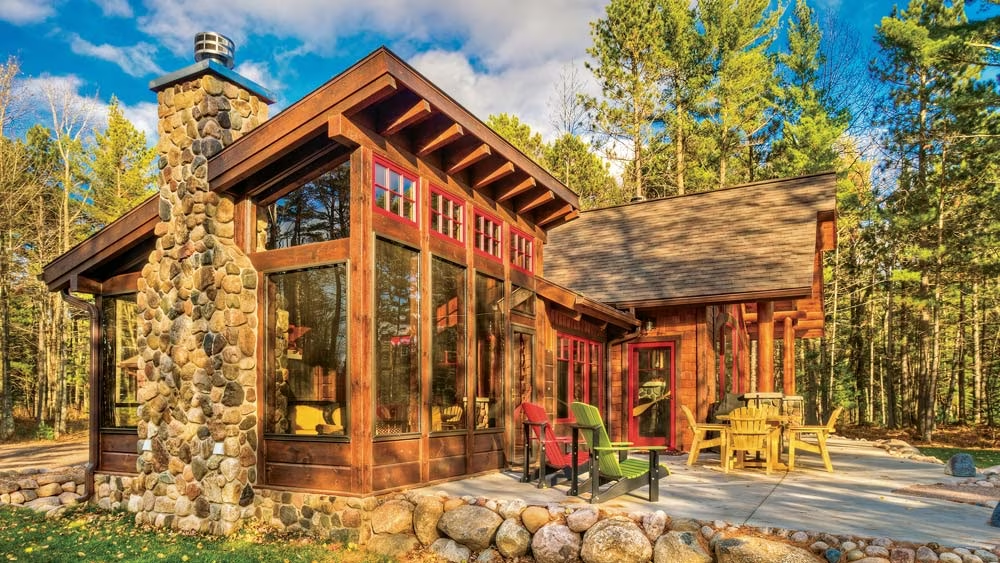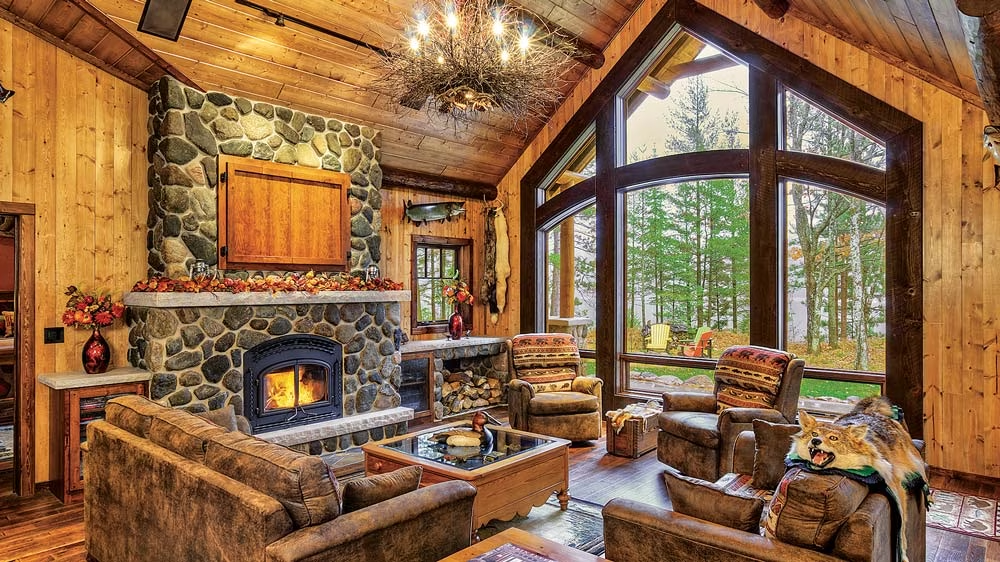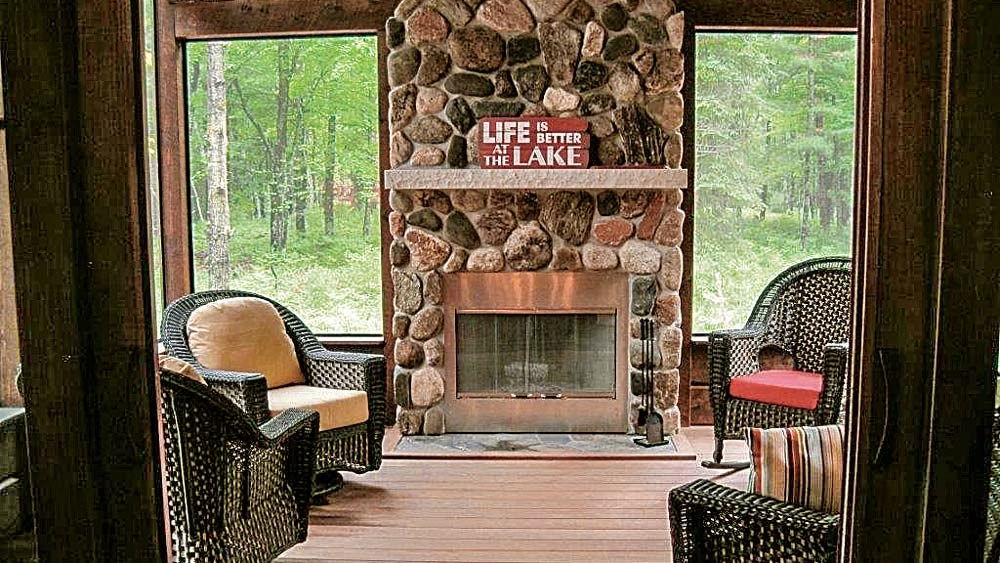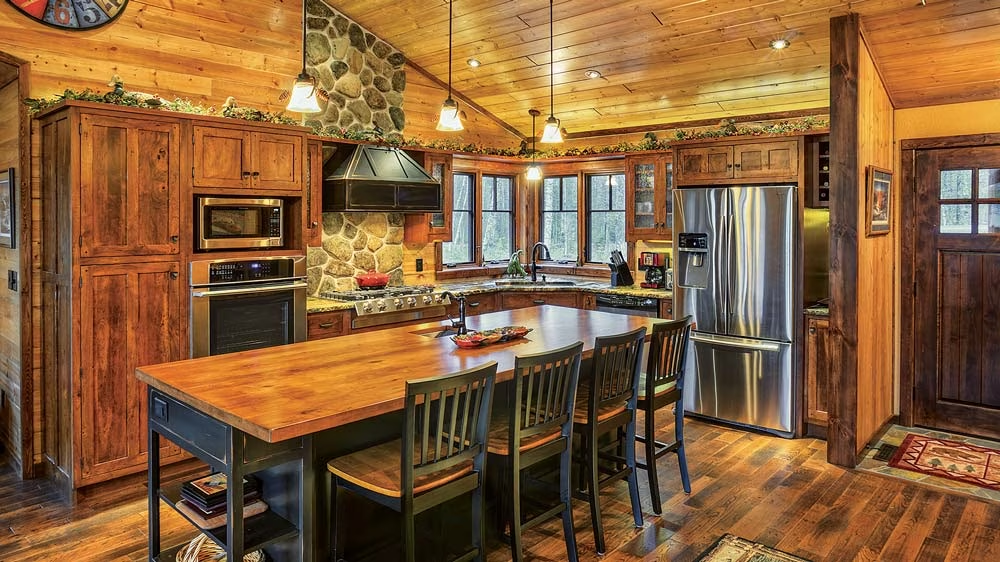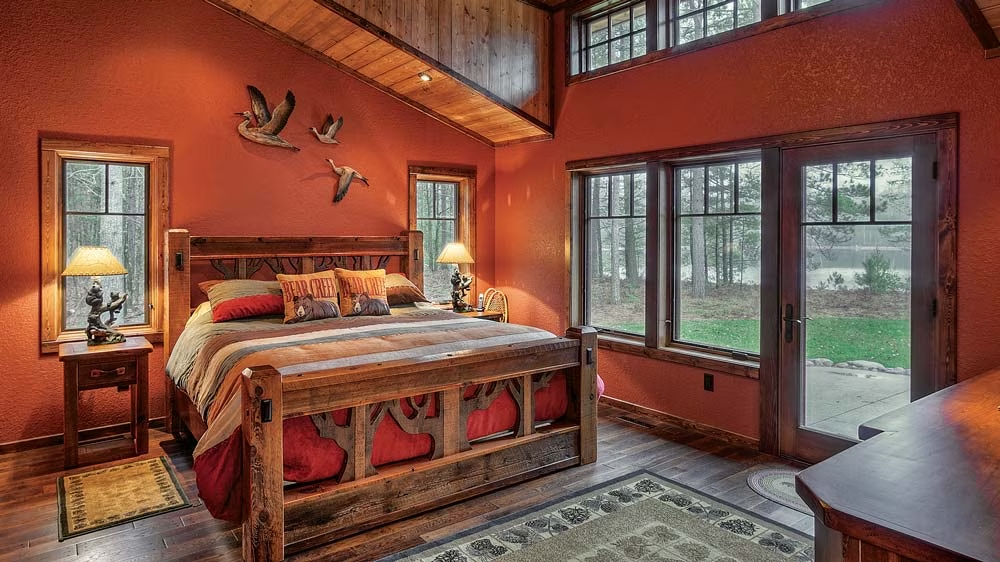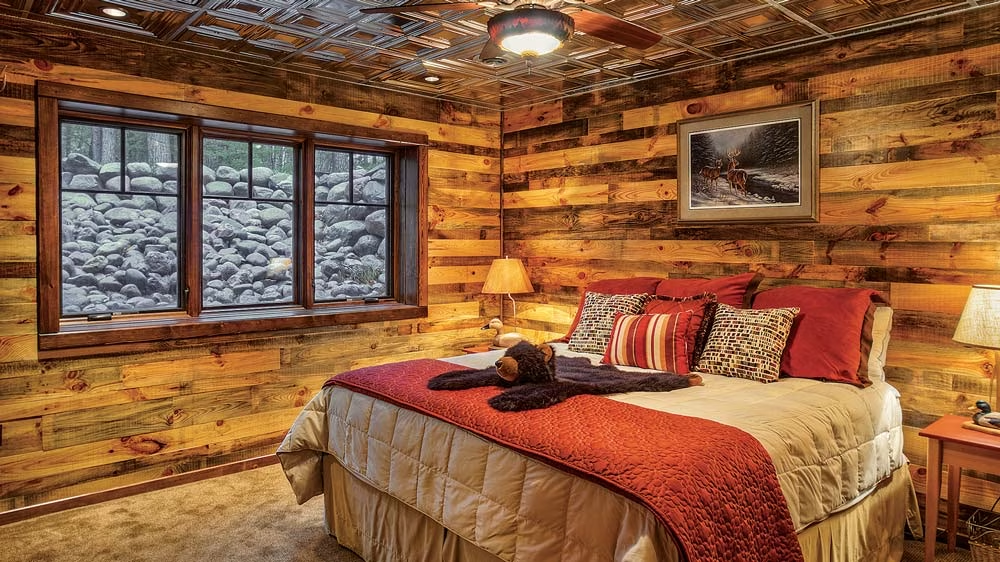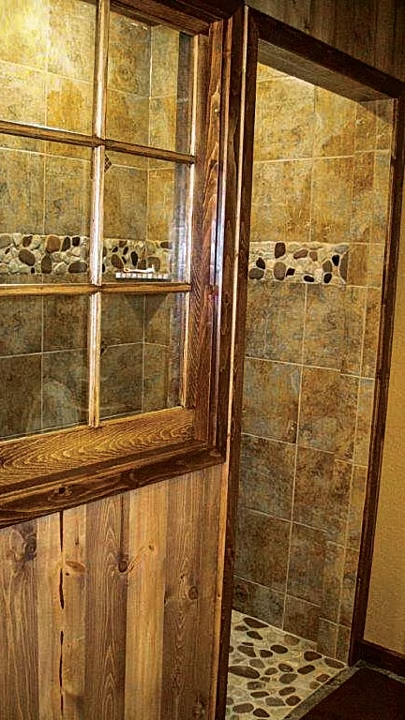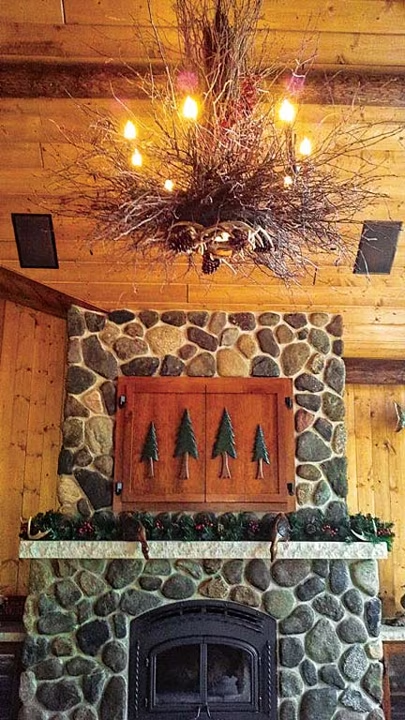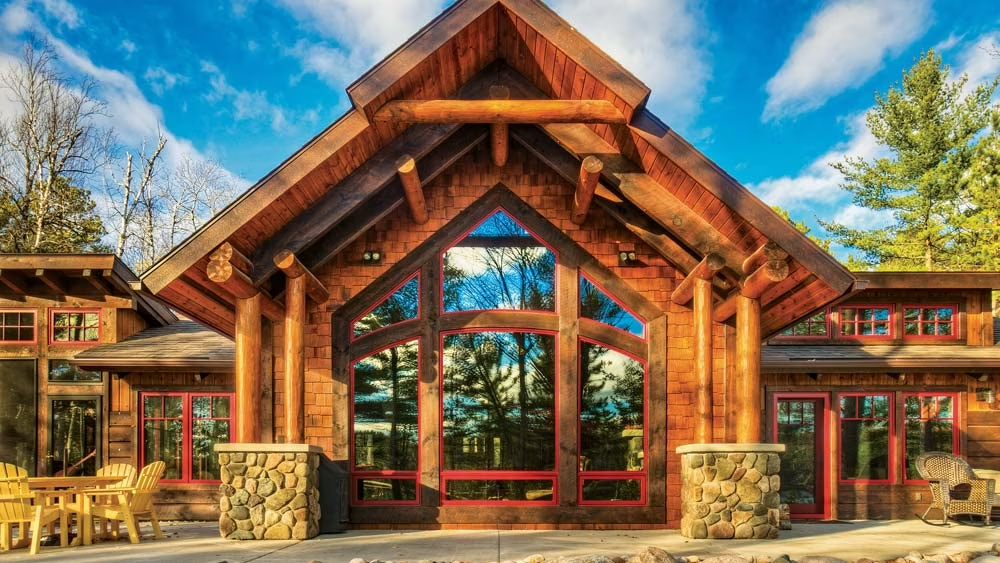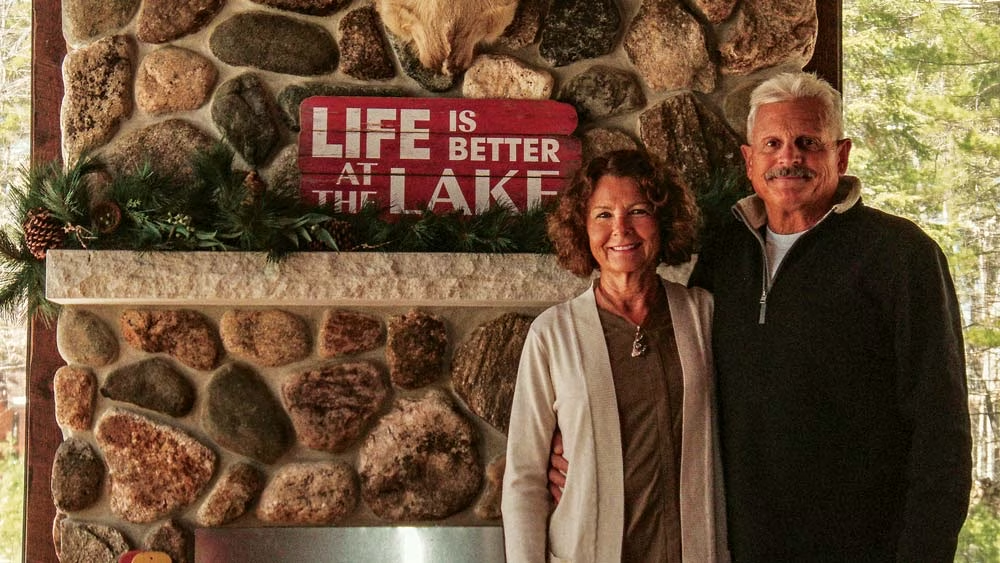Story by Julie Kuczynski
Photos by Hoffman Photography, Courtesy Tomahawk Log & Country Homes
Randy and Janelle Lang consider themselves “northwoods people.” Ever since Randy was a small boy, he’s vacationed in northern Wisconsin, taking in the beauty of dark pine forests reflecting on clear lake waters, and learning the sounds and footprints of the wildlife around him. His experiences gained him a connection with nature that never left him.
Janelle, who grew up in Milwaukee, was no stranger to cabin living “up north.” So, it’s no surprise that the two met and settled in together in Wausau, Wis., located in the north-central part of the state.
Three children and five grandchildren later, both Randy and Janelle were ready to retire from an engineering firm they owned together. They decided it was time to sell their home and a small cabin they had in the North Woods, and build their own year-round retirement cabin a little farther north. They wanted to downsize from their home in Wausau, and couldn’t be happier with their decision.
The Langs picked the Manitowish Chain of Lakes area to build, which was a natural choice for them. Randy had visited the area frequently with his parents. “We had a cabin for many years on a small lake by Mercer, which is just down the road. So we had roots in this area for many years,” he explains.
The Langs’ property is on one of the 10 lakes within the chain, and the land is mostly wooded. And, they are right on the water, which they love.
Designing a Dream
When looking for a builder, the Langs wanted to find a company that “got them more excited,” as Randy puts it, and that would give them value for their dollar. They chose Tomahawk Log & Country Homes after a number of lackluster interviews with other builders. With Tomahawk, the Langs just clicked, and the company responded very rapidly and professionally to all the couple’s questions and needs.
The Langs created their own plan for the cabin home, and Tomahawk’s internal design team worked with what the couple sketched out. In the end, about 90 percent of the design came from the Langs, with a few elements added by Tomahawk.
Troy Gullo, sales manager and design consultant at Tomahawk, worked with Randy and Janelle on their design. He says Randy had a fair share of ideas and his background in engineering was definitely beneficial. “Someone who is as organized as Randy is, and thorough as he is, it makes a project run a lot smoother – because you know what he is looking for,” Gullo says.
Planning Ahead
Knowing that it was going to be their retirement home, the Langs wanted to minimize square footage and build on one level. They knew they would not want to be climbing a lot of stairs in the future. They built the main level, and after that was completed, they decided to finish off their basement for additional living space. Separating the project into two phases allowed them to plan better and to save money.
Because their lot is very level, the Langs opted not to add a walkout basement. But, they did create a large berm area with rocks by clearing away some ground near the cabin so windows could be added in the basement. In a sense, the Langs created their own version of an exposed basement to let light in.
A guest bedroom was planned for the lower level, and being able to add windows allowed the space to be safe, inviting and seem less like a basement. “The berm areas are maybe 15 feet square, rather than just window wells,” Randy mentions.
The cabin has two bedrooms and two full baths on the main level and one bedroom and one full bath on the lower level. There is also a large family room with a fireplace on the lower level.
The ceiling in the guest bedroom is made of tin. The Langs chose this for beauty, but also for function, since it allows them to access the underside of the main level floors. “I wanted it fully accessible,” Randy says. “I didn’t want to have it ‘drywalled in.’ We have minimal drywall in the house. It is basically an accessible lay-in ceiling. And we liked the tin look.”
Making a List
There were a few “must haves” for the Langs when building their permanent cabin. Janelle mentions the fireplaces. They wanted to have wood-burning stone fireplaces in the great room and on their screened porch. The lower level fireplace is gas, for convenience, so they don’t have to carry wood down the stairs.
The screened porch was essential, too. It gets used year round. “When you live in the North Woods, and you have mosquitoes in the summer, you need to have a screen porch,” Janelle explains. And in the cooler seasons: the fireplace makes the living area on the porch a favorite spot to sit and relax.
Another must when designing the layout was a lake view from all the primary rooms. The great room, dining room and kitchen are all open and look out to the lake. Plus, the master bedroom contains a number of windows on the lake side of the cabin. “It was real important to us that we had a lot of windows in the home,” Janelle says. The large window grouping in the great room was Randy’s idea and design.
Hands-on Help
Randy has worked in construction for most of his life, so he put his skills to good use, wiring and doing the electrical work in the cabin himself. It was beneficial for everyone that he was on the job site on a regular basis, because he was able to answer any questions or concerns the builders had during the process.
Randy installed wireless lighting controls that utilize radio-frequency signals to activate dimming modules. The controls are completely programmable so any switch can control any light in the house.
Some of the elements Tomahawk used on the Langs’ home gave the company ideas to use in future homes, Gullo says. “There are some characteristics to that home that really have become a starting point for us,” he says. “Even the siding that was done on the home, we now have a name for. We’ve done certain things similar to it, but not exactly as it was done on Randy’s place. We now have what we call ‘rustic plank,’ named after what he used on his particular project. It’s a look that more and more people are interested in today.” The Langs’ siding is rough-sawn pine with a 10-inch stack height. Tomahawk now offers this siding in stack height ranging from 6 to 12 inches.
Years ago, Randy and Janelle thought they wanted to build a log home, but they changed their minds and went with a hybrid form that incorporates plenty of wood, stone and log accents inside as well as out.
“They took the conventional frame and added logs to it,” Gullo says. “It took the timber-frame look in some areas, and the log look in certain areas. Many different elements were mixed within to give it its striking appearance, but cozy feel.”
“We studied many magazines and pictures and cut out the pictures of features we liked,” Janelle says. They gathered photos until they had a firm idea of how they wanted the home to look. Today, they are very happy with the way it turned out.
Going With the Flow
Part of the fun of building a new home is making decisions on the interior design and décor. The Langs created a rustic look at their place after a lot of research. “We did a lot of looking, and we probably bought just about every log home cabin magazine there was for about five years,” Randy says. They also attended many log home shows for ideas.
The couple picked out all the wood and materials themselves. “Probably one of the most difficult things was getting the colors right with the stain on the wood,” Janelle says. “That’s a little tricky, cause when you look at a small sample of something, and then you look at it on a big surface, it doesn’t always look the same.” It is important to note that different lighting can also affect the look.
Certain finishes and accents were used in order to keep a certain consistency. “When you splash too many things up within a home, and you have different stack heights … it begins to start looking piecemeal,” Gullo explains. “There’s a really nice flow that this home has. It’s a very classy home, with a lot of thought put into the consistency.”
Pine was used throughout most of the home. The interior walls are knotty pine. The flooring, with in-floor heating, is white oak with a burnished cherry finish manufactured by Tennessee Wood Flooring.
Reclaimed materials weren’t used in the build, but the look was achieved. “What was really neat about the flooring that Randy chose, was that it was made to look very rustic,” Gullo says. The flooring was stained and distressed to make it look reclaimed. “It was fitting with the cabin,” Gullo says.
Another rustic touch is the twig chandelier Randy constructed for the great room using alder branches harvested from a local swamp. Also in the great room above the fireplace are bifold doors covering a TV. “We made the bifold doors so that painted panels can be placed on the doors creating a picture. The panels are removable, so we can have a painting for each season,” Randy says.
Gullo says that the TV cabinet was an interesting touch and perfect for the location near the fireplace. “It was a good way to keep heat off of the TV.” It also allowed the Langs to keep the TV lower for viewing.
Over time, and throughout their travels living the northwoods lifestyle, the Langs collected stones from the shores of Lake Michigan and Lake Superior. As a personal touch, they added these stones to the showers in their cabin home.
Life on the Lake
The Langs don’t miss out on the opportunities at their doorstep. Their family loves hunting, fishing, boating, swimming, hiking, snowshoeing and snowmobiling. Randy is the hunter in the house. Janelle mentions with a laugh, “I have dolls, he has deer.”
They have a pontoon boat, and Randy jokes that they have a lot of boats. They love taking the pontoon out on the chain of lakes because they can go for a long time from one lake to the next.
It can be hard to get the entire family together, especially with their daughter now living in California with three of their grandchildren, but everyone tries to visit for the Fourth of July week – a prime time to visit, given the normally beautiful weather. “Summer is the time to be up here to enjoy the lake,” Janelle says.
The couple also likes to spend a few of the winter months in the Florida Keys every year (when the weather is unacceptable in Wisconsin, of course). They do mention that Christmas can be fun at their cabin home though. “Up here, it is a winter wonderland,” Janelle says. “Being in the North Woods is fun at any time of the year.”
Living where and how they do, Janelle comments, “I can’t think of a nicer way to enjoy the beauty of nature than sitting out on a dock overlooking the lake or watching the animals and the woods, or walking in the woods. It’s just a very relaxed, comfortable lifestyle. I tell you, everyday I’m thankful that I get to live in this beautiful place.”
Janelle calls what they have “their little piece of heaven.” Randy remarks: “Well, I guess I have to echo that. They do say, ‘Heaven has a dock.’?” Wisconsin native Julie Kuczynski agrees that with the state’s weather, there is no better time to be “up north” than in July.
Building Efficiently
Tomahawk Log & Country Homes builds a broad spectrum of homes at many different sizes – and budgets. But Troy Gullo of Tomahawk says, the company doesn’t want to see people cut corners just so they can afford their house. A solution? Plan an efficient build.“We’ll often play with cost, but we don’t want to see people do it in the wrong area,” he says.
“Two, three, four years back it seems that people started paying attention to, ‘why do I need all this house?’ I think people are a little bit more wise to not overbuilding,”Gullo says.
But, no matter what size a home is, Gullo says it is always about efficiency. “It’s about laying things out so that there’s not wasted space and there’s not a lot of hallways. No matter what someone’s budget is, you can blow it away by not being efficient.”If you have a smaller place or a smaller budget you have to focus on efficiency.
“The difficulty with a smaller home is that the fixed costs really hit you hard. Whether you do 1,500 square feet or 3,500 square feet, you still have a well, a septic, a driveway, a kitchen, a fireplace, a furnace, you name it, all these fixed costs really start to hit hard. Now, you don’t have as much square footage to divide that into,” Gullo explains. “The per square foot cost of your house then seems really elevated or really high, but the thing is, there are certain things that are there no matter what size you build.” He advises to keep these fixed costs in mind when weighing the size of your cabin plan to help you find the most efficient potential for your space.
Cabin Stats
Built: Completed in 2013
Location: Manitowish Chain of Lakes, Wis.
Square feet: 1,699
Finished basement square feet: 1,097
Outdoor living square feet: About 800-850
Bedrooms: 3
Baths: 3



